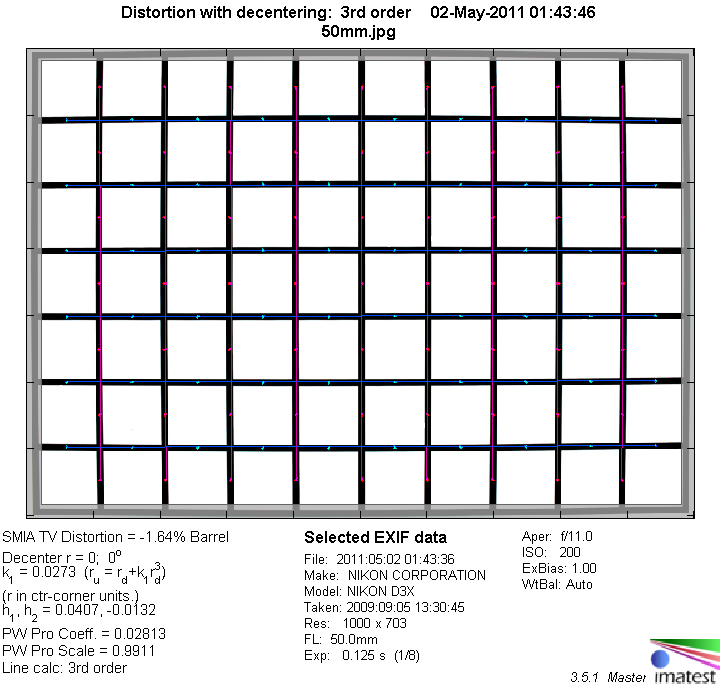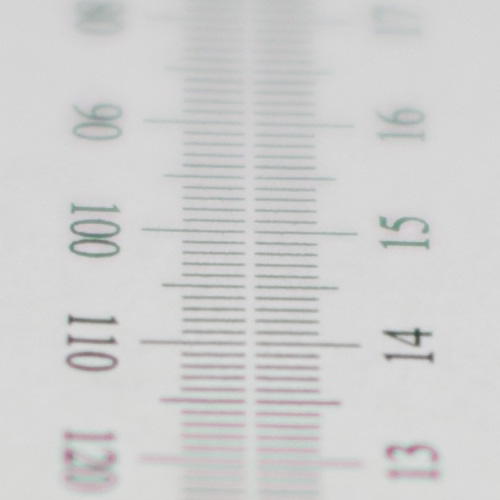|
Page 2 of 3

Distortion
The Sigma produces a moderate degree of barrel distortion on full format cameras. This may be visible and disturbing at times although it's far from being extreme.

The chart above has a real-world size of about 120x80cm.
Vignetting
Typical for ultra-large aperture lenses there's quite a bit of vignetting at max. aperture. You will likely notice this in field images. The situation eases at f/2 but you will need to stop down to f/2.8 till the problem is really well controlled.
We're performing our vignetting analysis based on
(uncorrected) JPEGs straight from the camera. The JPG engine of the Nikon D3x features a rather flat
gradation curve, thus has a moderate contrast characteristic, resulting in comparatively low vignetting figures - the
corresponding Canon figures are roughly 40% higher due to the more
aggressive default contrast setting.

MTF (resolution)
The Sigma produced fairly typical resolution figures for such a lens. The lens is sharp in the image center at f/1.4 but the borders/corners are poor on full format images here. The quality increases gradually when stopping down. The center is starting to show very good results at f/2 and it's excellent from f/2.8 onwards. However, the borders/corners remain unimpressive at large apertures. You need to stop down to f/5.6 in order to get good results here and the quality barely reaches very good levels at f/8, which is also the global sweet spot of the lens.
In the field the lens has some trouble at extremely close focus distances and large aperture settings.
Please note that the MTF results are not directly comparable across the different systems!
Below is a simplified summary of the formal findings. The chart shows line widths
per picture height (LW/PH) which can be taken as a measure for sharpness.
If you want to know more about the MTF50 figures you may check out the corresponding
Imatest Explanations

Chromatic Aberrations (CAs)
Lateral chromatic aberrations (color shadows at harsh contrast transitions) are generally moderate with an average pixel width around 1.3px at the image borders. This is a good result in the full format scope and not an issue in the field for most subjects. In addition, CAs can easily be corrected in software or by the camera itself (if you shoot JPEGs and own a current Nikon DSLR).

Bokeh
The quality of the bokeh (out-of-focus blur) is a primary aspect for such a large aperture lens. The Sigma can produce good results but it has some flaws here. The background blur is smooth and buttery but the foreground can be very nervous at large apertures.
The rounded aperture shape in out-of-focus highlights remains pretty much intact all the way up to f/4 - that's in the center. In the image corners the disc deteriorate towards a "cat's eye" characteristic due to mechanical vignetting, which is, to be fair, quite normal.
In summary, though, the lens shows very good bokeh quality for a 50mm prime lens.

Bokeh Fringing
Bokeh fringing is a common issue with relatively fast glass. It's visible as halos of different colors in out-of-focus areas - magenta (red + blue) in front of the focus point and green beyond.
The Sigma does a comparatively good job here though. The problem is visible but although not overly disturbing at f/1.4 and from f/2.8 onwards it is usually not field-relevant anymore.
Please note that we've to use a fairly close focus setting for these tests. As mentioned the lens has some softness issues in such a scenario which is why the sample crop doesn't look overly impressive at f/1.4 and f/2.
Upon closer observation you may notice that the focus shifts quite a bit towards the back when stopping down ("Residual spherical aberrations").
|
Move the mouse cursor over the f-stop marks below to observe the respective bokeh fringing
|
| f/1.4 |
f/2 |
f/2.8 |
f/4 |
f/5.6 |
|

|
|